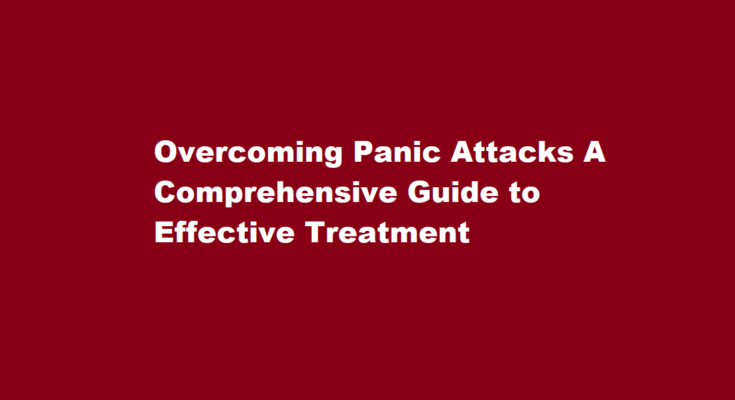Introduction
Panic attacks are intense and overwhelming episodes of fear and anxiety that can strike suddenly, leaving individuals feeling helpless and out of control. These episodes can be distressing and have a significant impact on a person’s daily life. However, with the right approach, panic attacks can be effectively treated, allowing individuals to regain control and lead a fulfilling life. In this article, we will explore various techniques and strategies to manage and treat panic attacks effectively.
Understanding Panic Attacks
Panic attacks are characterized by a sudden surge of intense fear or discomfort that reaches its peak within minutes. Symptoms often include heart palpitations, shortness of breath, trembling, sweating, and a sense of impending doom. Understanding panic attacks is the first step towards effective treatment. Individuals experiencing panic attacks should seek a medical evaluation to rule out any underlying medical conditions and to ensure an accurate diagnosis.
Breathing Techniques
Deep breathing exercises can be invaluable during a panic attack. Practicing controlled, slow, and deep breathing helps regulate the body’s stress response, reducing the severity of symptoms. Try the 4-7-8 technique: inhale deeply for a count of four, hold your breath for seven counts, and then exhale slowly for eight counts. Repeat this cycle until you feel more relaxed.
Cognitive Behavioral Therapy (CBT)
CBT is a highly effective therapeutic approach for treating panic attacks. It focuses on identifying and modifying negative thought patterns and behaviors associated with panic attacks. A trained therapist can guide individuals to challenge irrational thoughts and develop coping strategies to manage anxiety and panic. Through CBT, patients learn to reframe their thoughts and adopt healthier behaviors.
Mindfulness and Meditation
Practicing mindfulness and meditation techniques can help individuals become more aware of their thoughts and physical sensations during a panic attack. By staying present and non-judgmental, mindfulness helps reduce anxiety and panic symptoms. Regular meditation can also increase resilience to stress over time.
Lifestyle Changes
Healthy lifestyle habits can play a significant role in managing panic attacks. Regular exercise, sufficient sleep, and a balanced diet are essential components of maintaining overall mental and physical well-being. Reducing caffeine and alcohol intake can also minimize the likelihood of triggering panic attacks.
Medication
In some cases, medication may be prescribed to manage panic attacks. Antidepressants and anti-anxiety medications, such as selective serotonin reuptake inhibitors (SSRIs), can be helpful in reducing the frequency and intensity of panic attacks. However, medication should be used in conjunction with other therapies and under the guidance of a qualified healthcare professional.
Exposure Therapy
Exposure therapy involves gradually exposing individuals to situations or triggers that induce panic attacks. By confronting these triggers in a controlled and safe environment, individuals can learn to cope with anxiety and break the cycle of fear associated with panic attacks.
Support Network
Building a strong support network is crucial for individuals dealing with panic attacks. Talking to friends, family, or joining support groups can provide a safe space to share experiences and gain valuable insights. Having a support system can also offer comfort during challenging times.
Self-Help Strategies
Self-help strategies can complement professional treatment. Engaging in activities that promote relaxation, such as yoga or hobbies, can reduce stress and anxiety. Keeping a journal to track triggers and emotions can also aid in identifying patterns and progress.
FREQUENTLY ASKED QUESTIONS
Can panic attacks be cured?
Panic disorder is treatable and you can make a full recovery. But it’s best to get medical help as soon as you can. If you do not get medical help, panic disorder can escalate and become very difficult to cope with.
What is the 3 3 3 rule for anxiety?
The 333 rule for anxiety is an easy technique to remember and use in the moment if something is triggering your anxiety. It involves looking around your environment to identify three objects and three sounds, then moving three body parts.
Conclusion
Panic attacks can be debilitating, but they are treatable with the right approach. Seeking professional help, adopting healthy lifestyle habits, and practicing coping techniques are essential components of effective treatment. Remember that everyone’s journey is unique, and progress may take time. Be patient and kind to yourself throughout the process.
If you or someone you know is struggling with panic attacks, don’t hesitate to reach out for help. With the right support and dedication, it is possible to overcome panic attacks and regain control of your life. Remember, you are not alone, and there is hope for a brighter, panic-free future.
Read Also : Understanding and Managing Migraine Effective Treatment Strategies



